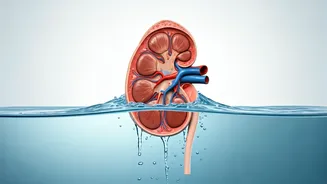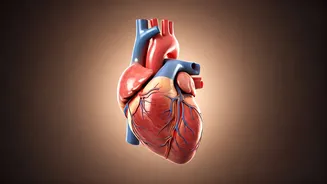Early Warning Signs
One of the earliest indicators of overhydration is consistently clear urine. Healthy hydration typically results in light yellow urine, and frequently
clear urine suggests the body is processing more water than needed. This situation can be an early signal of overhydration, especially when a person is not very active or when they're not in a hot environment.
Muscle Cramps and Spasms
Electrolytes, such as sodium, potassium, and magnesium, help the muscles function properly. When excess water dilutes these electrolytes, it can disrupt muscle function. Cramps, twitches, and spasms can then strike without any warning. These cramps can happen in the legs, arms, or abdomen, and may even feel similar to fatigue from exercise, despite a lack of strenuous activity.
The Swelling Effect
Excess water can cause various body parts to swell. This swelling often occurs in areas such as the hands, feet, lips, and face. This happens because the kidneys cannot remove the excess water quickly enough, and the water then enters cells and tissues. The skin might also appear pale, stretched, or slightly discoloured because of fluid accumulation beneath the surface.
Headaches and Brain
Persistent headaches are a key sign of overhydration. When sodium levels drop dangerously low, water enters brain cells, causing them to swell, a condition known as cerebral oedema. Since the skull cannot expand, even slight swelling increases pressure, triggering intense headaches that may worsen over time and don’t improve with drinking more water. This is because the brain cells are swelling due to a fluid imbalance.
Nausea, Vomiting, Dizziness
As water dilutes the body's sodium levels, the body may react adversely. Nausea, occasional vomiting, and dizziness can occur when an electrolyte imbalance interferes with digestive and neurological function. These symptoms are often mistaken for dehydration, but in overhydration, they stem from fluid overload rather than a lack of fluids.
Mental Impairment
Excess water can impair normal brain function. When neural cells swell, people may feel mentally slow, confused, forgetful, or unable to focus. Disorientation, sudden mood changes, irritability, or brain fog are all neurological signs that the brain is under pressure due to a water volume imbalance rather than dehydration.
Breathing Difficulties
In extreme water toxicity, brain swelling can affect areas that regulate breathing. As pressure increases, normal respiratory function can slow or become irregular, leading to shortness of breath or difficulty breathing. Without prompt medical care, this can quickly become life-threatening.
Frequent Urination
Urinating more than 8 to 10 times a day may signal that the kidneys are working overtime to remove excess water. Although bathroom frequency can increase with caffeine or high fluid intake, a consistent need to urinate, especially when urine is clear, can indicate that the body is unable to maintain a healthy water-sodium balance. This constant flushing can also strip the body of electrolytes over time.
Fatigue and Exhaustion
Drinking too much water forces the kidneys to work harder than normal to filter and flush the excess fluid. This strain can trigger hormonal stress responses in the body, leaving a person feeling unusually tired, weak, or physically drained. Some people report difficulty getting out of bed or feeling wiped out despite resting, as the body struggles to maintain internal balance.
Risks and Prevention
Drinking excessive water can dangerously dilute sodium levels in the blood, leading to hyponatraemia, a condition that disrupts fluid balance, nerve activity, and muscle function. When sodium levels fall below 135 mEq/L, water moves into cells, causing them to swell. The brain is particularly vulnerable since the skull cannot expand to relieve pressure. Research shows early symptoms may include fatigue and poor concentration, while severe cases can escalate to confusion, seizures, respiratory distress, coma, and even death. The (IOM) recommends 2.7 litres per day for adult women and 3.7 litres for adult men, including fluids from food sources as well as drinks.













